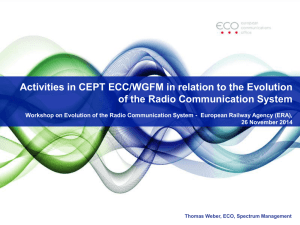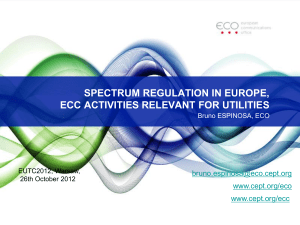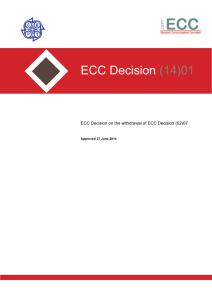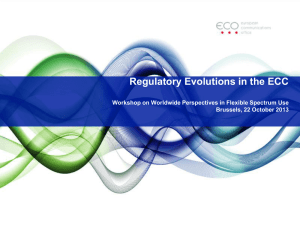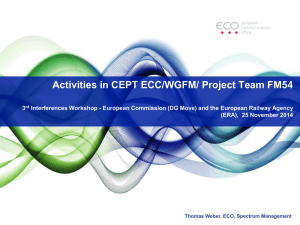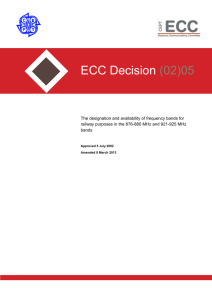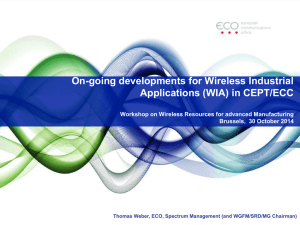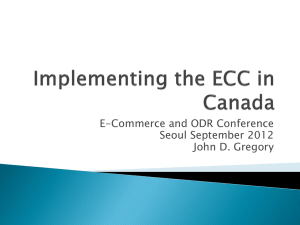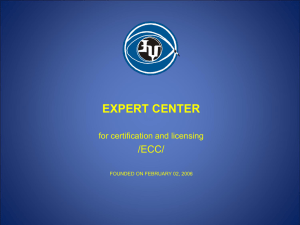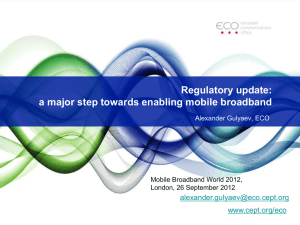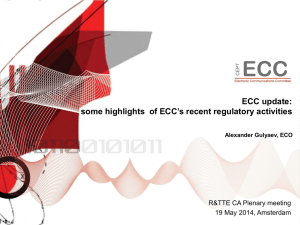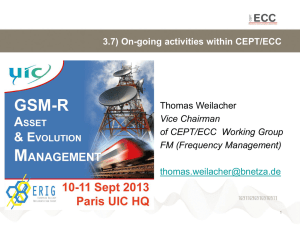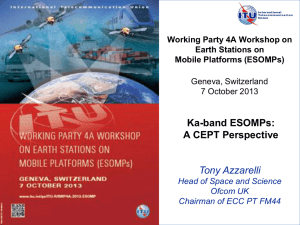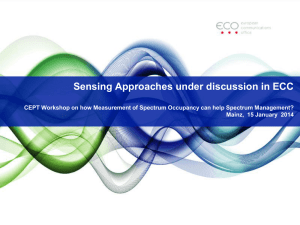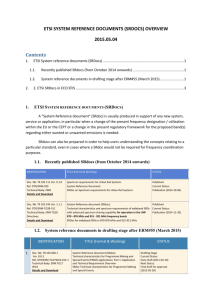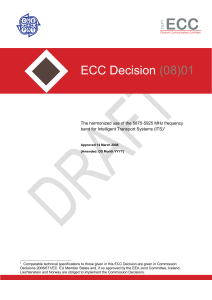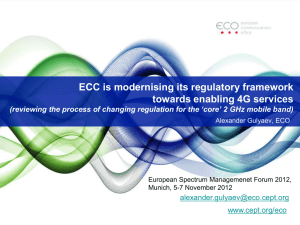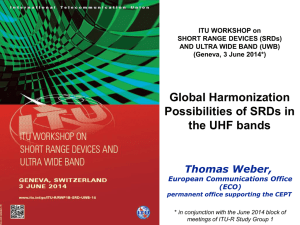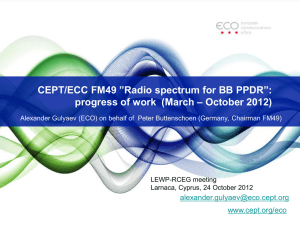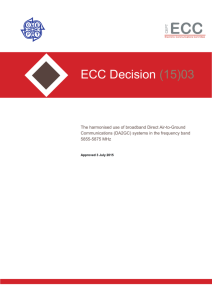Activities and Principles Applied for the Internet of Things
advertisement
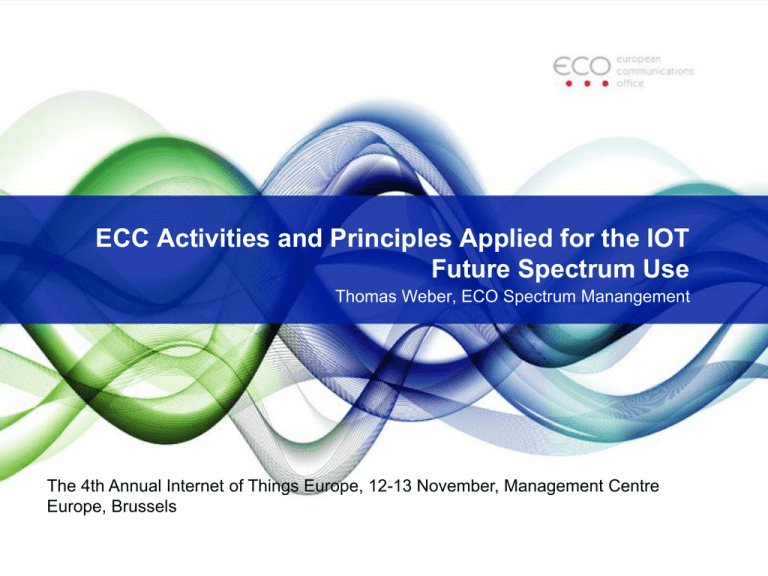
ECC Activities and Principles Applied for the IOT Future Spectrum Use Thomas Weber, ECO Spectrum Manangement The 4th Annual Internet of Things Europe, 12-13 November, Management Centre Europe, Brussels Work in the ECC on Smart Grids / Smart Metering (and others – under the UHF Roadmap) • Work in ECC WGFM SRDMG was triggered by 4 ETSI System Reference Documents: – DEFINITION OF THE REQUIREMENTS ETSI SRDoc TR 102 649-2 (SRD and RFID appl, incl SM/SG, 870-876/915-921 MHz) ETSI SRDoc TR 102 886 (SM in 873-876 MHz) ETSI SRDoc TR 103 055 (SM/SG in 870-876 MHz) ETSI SRDoc TR 103 056 (Alarms/Social alarms 870-876 MHz) • ECC WGSE is conducting spectrum compatibility studies • ECC WGFM SRD/MG collected spectrum inventory information and creates ECC Report 189 which includes identification of the objectives/benefits, assessment of the demand/of the ETSI request , need for harmonisation as well proposal for choice of frequency regulatory framework and frequency options for each application • Full pan-European immediate harmonisation unlikely because of governmental services in all or parts of the 870-876/915-921 MHz bands in 11 (of 48) countries. SRD Strategy as applied under ECC Report 189 under development • Frequency Management will focus on technology and application-neutral solutions to keep flexibility, avoid spectrum fragmentation and foster innovations. At the same time, some applications need very predictable sharing environments -> no special application categories in UHF for SM, alarms or automotive applications, sharing is rather based on application-neutral medium access conditions. • Most applications are using Low duty Cycle / Duty Cycle. Some are organised in ICT networks (some SM, M3N-> Metropolitan Meshed Machine Networks). • Smart Grids: seen almost exclusively on electricity generation side. Reliability, availability requirements are very high (e.g. in the order of 99.9995%) and security issues attached. Seen as incompatible with the SRD concept (no harmful interference, no protection). Either wired or use of other available existing radio regulations (mobile networks, PMR/PAMR, Fixed Services) Smart Metering • Metering scenarios, one can distinguish between • • • (a) meter - home gateway (b) meter - neigbour gateway (c) meter - network gateway • M3N combines the smart metering and smart grids by means of meshed networks • No exclusive frequency ranges foreseen • The use of the frequency range 169,4-169,8125 MHz is in the process of being revised and is available for smart metering (complementary to UHF) • Sub-GHz bands between 400-500 MHz or 800-1000 MHz are the most cited in the discussions for wireless metering technologies, offering a combination of large coverage area and low bit rates with smaller coverage distance and higher bit rates. • The results of detailed investigations performed also confirm this view due to the propagation characteristics above 1 GHz limit drastically the possibility to reach all the endpoint / metering sensors in a network (often inside, or even in basements). Proposal under Study (lower band) ETSI TR 102649-2 Generic / non – specific SRDs (TR102649-2) 25mW e.r.p. with (L)DC of up to 1% or LBT + AFA or equivalent techniques TR 102649-2: It is expected that the Application specific ETSI TRs boundary between non-specific and specific SRDs will lie somewhere between 873 MHz and 874 MHz. The exact frequency will be determined following the compatibility study when the impact of GSM-R on the upper part of the band has been quantified -ES 202630 -TR102886 -TR103055 -TR103056 DC 1% 100mW 800kHz Specific SRDs (TR102649-2) transmit power & (L)DC (Note1) Draft “SRDs with LDC” (ES 202630) 100mW e.r.p. & (L)DC & 200kHz spacing “Smart Metering” (TR102886) 100 mW / 200 kHz / DC<2.5% Aloha or CSMA/CS access “M3N and SM” (TR103055) DC 1,25% / 100mW e.r.p. / 200kHz spacing “Alarm / Social Alarm” (TR103056) dedicated 400kHz with LDC / 25mW e.r.p. ER-GSM Existing SRDs 870MHz 871MHz 872MHz Note 1: proposed transmit power + (L)DC restriction: 873MHz 874MHz - 1 mW e.r.p. - 25 mW e.r.p. - 100 mW e.r.p. 875MHz Up to 5 % D.C Up to 1 % D.C Up to 0,1 % D.C R-GSM 876MHz fC 919,9MHz 4W e.r.p. / BW: 400kHz RFID fC 918,7MHz 4W e.r.p. / BW: 400kHz ETSI TR 102649-2 fC 917,5MHz 4W e.r.p. / BW: 400kHz fC 916,3MHz 4W e.r.p. / BW: 400kHz Proposal under study (upper band) < -18 dBm e.r.p/100 kHz. per tag and fc ± 1 000 kHz for tag response Non-specific SRDs: 0,1W 0,1W 0,1W 0,1W 25mW e.r.p. with 1%DC or LBT / AFA and 200kHz spacing Application specific ETSI TRs: -TR103056, TR 102 791 “Alarm/Social Alarm”, sharing with other SRDs (TR103056) 2*200kHz with LDC / 25mW e.r.p. Assistive Listening Devices (TR 102 791) 10 dBm/100%DC ER-GSM (base stations) “GSM” mobile 915MHz 916MHz 917MHz 918MHz 919MHz 920MHz R-GSM 921MHz Work in the TV White Spaces 470-790 MHz - An outcome of the first phase of SE43 activity relating protection of PMSE (ECC Report 159): Sensing approach considered problematic solution; A geo-location database considered feasible solution; Safe harbour channel (s). - Chapter 11 ”List of areas requiring further study” (ECC Report 159) suggests to continue technical and regulatory considerations regarding protection of PMSE service. - ECC Report 186 (technical supplement to ECC Report 159) providing results on the outstanding issues – currently under public consultation Principle results may also be used in other bands - ECC Report 185 - currently under public consultation – covering geo-location w/o sensing – e.g. requirements for master-slave WSD configurations and link to the geolocation database. - No definition of requirements via industry request/ETSI Srdoc ! - WRC-15 Agenda Items 1.1 and 1.2 -> upper frequency edge may be lower in the future Participating in ECC work: where to start www.cept.org/ecc Thanks for your attention Thomas.Weber@eco.cept.org www.cept.org/eco www.cept.org/ecc
